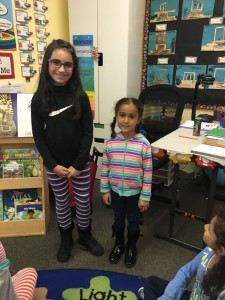Literatura
In this short week of school we completed our first Language Arts unit by reading Llueve, which is a poem about the rain that using silly rhyming words. Students also practiced their letter sounds sorts (which is great for vocabulary building!) and had a lot of fun! Our language arts learning objectives this week were to:
- compare and contrast images as parecidas (alike) or diferente (different).
- practice dictation of letter O words
- complete picture sorts for U and A words
- complete their first assessment (this is all about following directions, listening, showing what they learned through this long first unit. On Friday the students had their first formal assessment on beginning sounds, ending sounds, vowel identification, and rhymes.)
Matemáticas
This week we began our next math unit: Shapes and Patterns. Most students are already able to identify, name, and describe circles, squares, triangles, and rectangles. They are also able to recognize spheres, cubes, and pyramids. In this unit we will compare shapes, and determine how they are alike and different by describing their geometric attributes and properties. Our objectives this week were to:
- identify, classify, and describe plane shapes (Vocabulary: círculo /circle, triángulo /triangle, cuadrado /square, rectángulo /rectangle, lado /side, esquina/corner, clasificar /sort, color/color, parecido/alike, forma/shape, tamaño/size, diferente/different)
- make same and different shapes
- repeat the calendar pattern of geometric solid shapes.
History & Geography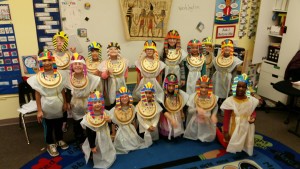
We finished our unit on ancient Egyptian civilization this week. We took a unit assessment and then had our Egyptian celebration. We ate Egyptian food, walked like an Egyptian, made classmates into mummies, and dressed up like pharaohs.
Our next section in this domain will be Three World Religions.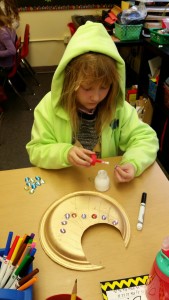
Our objectives this week were to
• locate Egypt on a world map or globe and identify it as part of Africa
• understand that much of what we know about ancient Egypt is because the work of archaeologists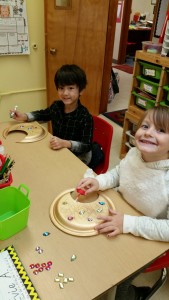
• identify to Tutankhamun as a pharaoh of ancient Egypt
• explain the significance of Tutankhamun
Science
This week in our Animals and Their Habitats domain we read about fresh water habitats and saltwater habitats.
Our objectives this week were to:
• identify the characteristics of the freshwater habitat
• explain the difference between freshwater and salt water habitats
• understand that saltwater covers most of the earth and it is found in several oceans
• identify and locate the oceans of the world on a globe: Arctic Pacific Atlantic Indian, Southern
• describe the landscape of the ocean floor
• understand that ocean life is very diverse
English Word Work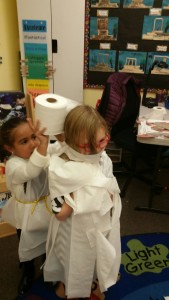
This week in spelling the Red group worked on t and v sounds, the Blue group had the diagraphs th and wh, and the Green group continued to review short vowel sounds. In our journals this week we wrote about a visit from veterans, Mr. Bob and Mr. Gary. Our word wall words this week were: our, out, day, down, ride, run.
Our vocabulary words this week were: priceless, veterans, saltwater.
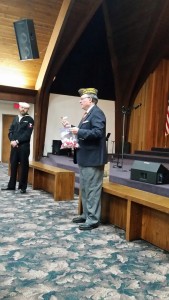 In honor of Veteran’s Day, we had two guest veterans from the VFW come speak to the students on Tuesday. The everyone did a wonderful job of listening and asking thoughtful questions.
In honor of Veteran’s Day, we had two guest veterans from the VFW come speak to the students on Tuesday. The everyone did a wonderful job of listening and asking thoughtful questions.
Specialists
Art with Ms. Kelly:
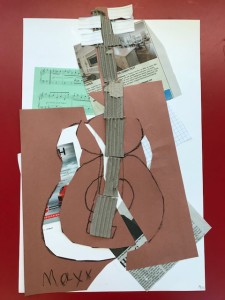 The students in all grades have been learning about Pablo Picasso this month in Art. We read a short book about this famous artist, and also looked at several examples of his artwork. Some of the art vocabulary words the students are learning about and/or reviewing this month are Cubism, Realistic, Abstract, and Collage.
The students in all grades have been learning about Pablo Picasso this month in Art. We read a short book about this famous artist, and also looked at several examples of his artwork. Some of the art vocabulary words the students are learning about and/or reviewing this month are Cubism, Realistic, Abstract, and Collage.
We’ve been focusing on Picasso’s use of the guitar and violin as a theme in his artwork. He created a variety of drawings, paintings, collages and sculptures depicting these stringed instruments, some of which are recognizable and some are not. The students then made their own version of a cubistic guitar using the collage technique. The kindergarten and first graders worked really hard on this challenging project!
The students learned how to draw a simple guitar shape by observing a real guitar, and using basic shapes. The following week they cut the guitar drawing into shapes and rearranged it on a background of a variety of papers. It was fun to look at the wonderful compositions (arrangement of shapes) when we displayed the artwork on the whiteboard! The 2nd and 3rd Grade class artwork is on the bulletin board at school. I think Picasso would have loved seeing all the students’ creative, abstract art!
It was great having Miss Erin teach the students about guitar music while we were working on guitar art! We’ll be doing one more Picasso art project at the end of the month.

